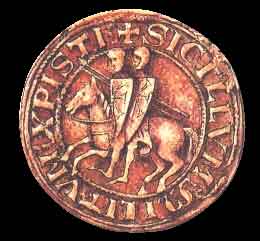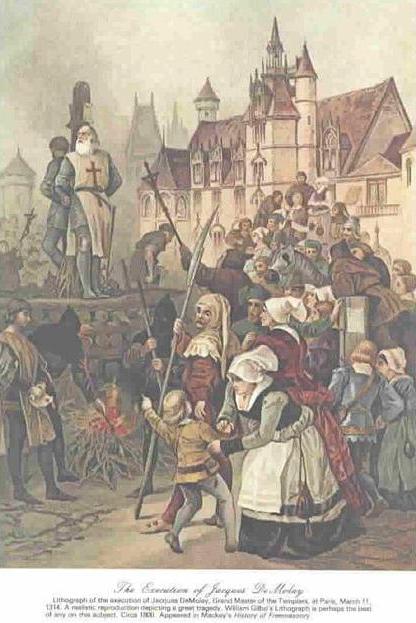THE KNIGHTS TEMPLAR
The Order of Knights of the Temple was founded in the Holy Land in1118 AD by a Burgundian Knight, Hugues de Payens. It's organisation was based on that of the Saracen fraternity of hashishim whom Christians called Assassins. The Templars first headquarters was a wing of the royal palace of Jerusalem next to the al-aqsa mosque, revered by the Shi'ites as the central shrine of the Goddess Fatima.
Western romances, inspired by Moorish Shi'ite poets, transformed this Mother-shrine into the Temple of the Holy Grail, where certain legendary Knights called Templars gathered to offer their service to the Goddess, to uphold the female principle of divinity and to defend women. These Knights became more widely known as Galahad, Perceval, Lohengrin etc.
The real Knights Templar, however, professed Christianity and assumed the duty of protecting Christian pilgrims and merchants travelling through the Holy Land. They also undertook to protect the travellers' lands, castles, and other properties back home, where Templars from Jerusalem arrived to take charge. When pilgrims failed to return from their journeys, the property could pass into the Templars' permanent possession. As a result, like other holy orders founded on a vow of poverty, the Templars soon became very rich.
At first the Knights Templar had difficulty getting papal sanction for their military order. The papacy refused to recognise them until a vindication of their aims was written by Saint Bernard, whose uncle joined the order and became a Grand Master. The Templars' original charter, signed by Pope Innocent II, granted them freedom from papal claims on their property, even from church taxation. This financial independence was to prove their downfall.
Having acquired estate, the Templars were accused of organised heresy, devil worship, ritual sodomy, and blasphemy. It was claimed they adored an androgynous idol named Baphomet, "having sometimes three faces, sometimes two, or only one, and sometimes a bare skull which they called their saviour, and believed its influence to be exerted in making them rich, and in making flowers grow and the earth germinate".
The rumour-mongers claimed the Templars secret rites involved denial of Christ, treading on the cross, and similar charges that were to become monotonously familiar in witch persecutions. Grand Master Jacques de Molay and other dignitaries of the order were arrested and confessed under torture, that they had indeed done such things, with the aim of teaching newly initiated Knights unquestioning obedience to their superiors' commands. Later, de Molay and his associates publicly renounced their confessions, saying they had been forced by torture. In 1314 they proclaimed their innocence before a large crowd of people and were burned at the stake as relapsed heretics the same afternoon.
The order was suppressed with great cruelty. With the church's blessing, local barons in France, Cyprus, Castile, and other areas simply murdered the Knights and took their properties. Captured Templars were forced to confess to every sort of crime, most apparently invited by their judges. It was found that each Templar confessed to one set of sins when tortured by one judge and a completely different set when tortured by a different judge. Trials were transparently rigged. During the trial of Templars at Paris, the court repeatedly refused to hear depositions from no fewer than 573 witnesses for the defence.
A few Templars managed to flee to England, where torture was not legal. This made it impossible to obtain what Pope Clement called "true evidence", meaning evidence extorted by torture. The pope wrote to King Edward II demanding that the Templars be arrested and tortured. Otherwise, Edward and his court would be excommunicated as impeders of the Inquisition. As a bribe, Edward was offered a Plenary Indulgence for all his past sins. Finally he permitted papal judges to torture the Templars, changing the English Law "out of reverence for the Holy See". The indispensable utility of torture was thus established, and "the success of the extermination of the Templars set the patterns for the subsequent persecution of witches".
Scholars have tried to determine the truth, if any, of the charges against the Templars. Most agree that the Templars "had adopted some of the mysterious tenets of the eastern Gnostics". Their alleged idol Baphomet may have been the Triple Head of Wisdom pictured on the arms of the orders' founder, in the form of three black Saracen heads. On the other hand, no idol of Baphomet was ever found in the Templars houses or shrines, though these were seized and sealed immediately.
Templars were accused of "making a fig" at the crucifix with their hands; but this derisive sexual symbol was not a mockery by eastern standards. Orientals called it a knowledge sign, the feminine counterpart of the phallic cross; in India it was a lingam-yoni. If the Templars trampled a crucifix, they may have copied the custom of Arab dervishes who ceremonially rejected a cross with the words "You may have the Cross, but we have the meaning of the Cross". As for the charge of sodomy, no monastic order was free of that. Men cut off from women were no less prone to homosexual behavior in the 13th century than in the prisons, barracks, lumber and mining camps, and boys' schools of the 20th.
GRAND MASTERS
of the KNIGHTS TEMPLAR
Hugh de Payens 1118 - 1136
Robert de Craon 1136 - 1146
Evererd des Barres 1146 - 1149
Bernard de Tremelai 1149 - 1153
Andre de Montbard 1153 - 1156
Bertrand de Blanquefort 1156 - 1169
Philip de Milly 1169 - 1171
Odo de St 1161 - 1171
Arnold de Toroga 1179 - 1184
Gerard de Ridfort 1185 - 1189
Robers de Sa 1191 - 1193
Gilbert Era 1193 - 1200
Philip de Pleas 1201 - 1208
William de Char 1209 - 1219
Pedro de Monta 1219 - 1230
Armand de Parigord ? - 1244
Richard de Bur 1245 - 1247
William de So 1247 - 1250
Reynald de Vichy 1250 - 1256
Thomas Barar 1256 - 1273
William de Beaujeu 1273 - 1291
Tibald de Gaudin 1291 - 1293
Jacques de Molay 1293 - 1314
ANOTHER VIEW
On Tuesday, November 27th 1095, Pope Urban !! launched the First Crusade accompanied by the cry of "Deus lo volt!" ("God wills it."). The pope launched the Crusades because of the religious persecution of the Muslim leaders in Jerusalem. This was a lie. The Muslim leaders practised a religious tolerance that all nations could learn from today. The Christian leaders in Byzantium had requested a small army from the Pope to help in some border wars. A huge army of Christian Knights, most hungry for land, invaded the Middle East. The Muslim's at the time were not quite prepared for the scope or ferocity of the Crusaders. So, by the year 1099, Jerusalem had fallen, as had several principalities in and around the Holy Land. Christian kingdoms were established.
In 1118, Hugh de Payens and eight other knights went to make the unusual commitment to monastic orders, as Knights. Most Knights, at the time, were fighting for money, land or power. Since Knights had to buy their own equipment, a vow of poverty was almost like a vow of non-violence. The stated reason for their order was to protect pilgrims on their way to the Holy Land. Baldwin II gave them the al-Aqsa Mosque on Temple Mount as their headquarters. This sight was also thought to be the exact location of the Temple of Solomon. The Knights took on monastic style orders and vowed poverty. Their symbol was two Knights on a horse to show just how poor they were.
For their first nine years, the Order didn't seem to grow. Bernard of Clairvaux, St Bernard, was out to destroy the enemies of the church. Since the Muslims had the effrontery to actually resist the first crusading army, they were, by definition, enemies. He almost single handedly built the Templars into the power that they became. Pope Innocent II issued a bull that exempted the Templars from all authority except the Pope. This was the final part of the foundation for them to begin to construct an international power structure. They built an army and a fleet. To feed and equip the army they bought farms and industry. The surplus money, since individuals in the Order had vowed poverty there was a lot of surplus, was then re-invested and lent. The church prevented usury (interest on loans) so the Order accepted gifts in the form of more land and equipment. The Templar army was drilled and trained as units on a large scale in a time when such training was unheard of. They also had secret initiations and meetings. This was the key to their downfall.
Not long after building a large army, the Templars turned away from their original purpose of protecting pilgrims. They began taking part in the efforts of the Christians to keep the land already taken and expand into further Muslim lands. To exacerbate the situation, St Bernard called for another crusade, stirring up warlike Knights in Europe who wanted to make a grab for the riches in the Holy Land. Pope Eugenius called for another crusade not long after he was forced out of the Papal See and was able to take refuge with Templar Knights. This was when the distinctive Templar emblem was established by the pope. The cross patee would be worn on the left breast of the all white robes the Templars wore into battle. True soldiers of Christ. (The same ones worn by Richard the Lion Heart).
For the next 100 years, the Templars fought along side the other Crusaders against all others. They fought along side Richard Coeur de Lion. They won the respect and fear of Saladin himself. Then the Templars made a fatal mistake. They got involved in the politics of Europe (they had always been neck deep in the politics of the Holy Land). Innocent III was more concerned with challenges to his authority that in the Holy Land. A collection of free thinkers known as the Cathars actually thought they could get to heaven with arranging it with the Pope. He called for a Crusade in southern France to purge this dangerous collection of heretics from the land. Templars took an active part.
Now thoroughly mixed into European politics, the tide turned against the Christians in the Holy Land. One kingdom after another fell. The huge forts fell one by one and finally in 1291, the final fort of Sidon fell. The Templars had lost all bases in the Holy Land. To them, this must have been their darkest hour. Unfortunately, things were going to get worse.
In France, the last of the Grand Masters of the order was selected, Jaques de Molay. The Templars' had made some sizeable loans to the King of France, Philip the Fair. Philip was embroiled in Papal politics and he was able to get his own puppet Pope on the throne. In 1306, Philip was still desperate for funds. He built an audacious plan to take the Templar treasure, Only one crime allowed a King to confiscate property - heresy. On October 13th, all Templars in France were arrested by order of the Pope and thus he disbanded his own personal army. He requested all Christian rulers to follow Phillip's lead. Then the torture began. Nearly all the Templars arrested were tortured in one way or another. They confessed to all sorts or nonsense from outright devil worship to systematic, organized homosexuality. Over the next few years, the order was broken up in all countries.
In 1314 on March 18th, the last of the Templars was burned at the stake. Supposedly, de Molay had time for a curse. He called for Pope Clement and Philip IV to join him within a year. Clement died the next month and Philip IV seven months later.
![]()



